The parkinsonian mimetic, MPP+, specifically impairs mitochondrial transport in dopamine axons
- PMID: 21562285
- PMCID: PMC3140916
- DOI: 10.1523/JNEUROSCI.0711-11.2011
The parkinsonian mimetic, MPP+, specifically impairs mitochondrial transport in dopamine axons
Abstract
Impaired axonal transport may play a key role in Parkinson's disease. To test this notion, a microchamber system was adapted to segregate axons from cell bodies using green fluorescent protein-labeled mouse dopamine (DA) neurons. Transport was examined in axons challenged with the DA neurotoxin, 1-methyl-4-phenylpyridinium ion (MPP+). MPP+ rapidly reduced overall mitochondrial motility in DA axons; among motile mitochondria, anterograde transport was slower yet retrograde transport was increased. Transport effects were specific for DA mitochondria, which were smaller and transported more slowly than their non-DA counterparts. MPP+ did not affect synaptophysin-tagged vesicles or any other measureable moving particle. Toxin effects on DA mitochondria were not dependent upon ATP, calcium, free radical species, JNK, or caspase3/PKC pathways but were completely blocked by the thiol-anti-oxidant N-acetyl-cysteine or membrane-permeable glutathione. Since these drugs also rescued processes from degeneration, these findings emphasize the need to develop therapeutics aimed at axons as well as cell bodies to preserve "normal" circuitry and function as long as possible.
Figures
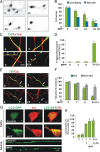
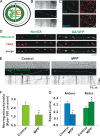
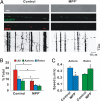

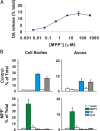

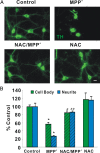
Similar articles
-
The Parkinsonian mimetic, 6-OHDA, impairs axonal transport in dopaminergic axons.Mol Neurodegener. 2014 May 3;9:17. doi: 10.1186/1750-1326-9-17. Mol Neurodegener. 2014. PMID: 24885281 Free PMC article.
-
Live imaging of mitochondrial dynamics in CNS dopaminergic neurons in vivo demonstrates early reversal of mitochondrial transport following MPP(+) exposure.Neurobiol Dis. 2016 Nov;95:238-49. doi: 10.1016/j.nbd.2016.07.020. Epub 2016 Jul 22. Neurobiol Dis. 2016. PMID: 27452482 Free PMC article.
-
Differential effect of catecholamines and MPP(+) on membrane permeability in brain mitochondria and cell viability in PC12 cells.Neurochem Int. 2002 Apr;40(4):361-9. doi: 10.1016/s0197-0186(01)00069-9. Neurochem Int. 2002. PMID: 11792467
-
Release of dopamine by perfusion with 1-methyl-4-phenylpyridinium ion (MPP(+)) into the striatum is associated with hydroxyl free radical generation.Brain Res. 2001 Jul 6;906(1-2):170-5. doi: 10.1016/s0006-8993(01)02238-7. Brain Res. 2001. PMID: 11430875
-
Elevated Mitochondrial Bioenergetics and Axonal Arborization Size Are Key Contributors to the Vulnerability of Dopamine Neurons.Curr Biol. 2015 Sep 21;25(18):2349-60. doi: 10.1016/j.cub.2015.07.050. Epub 2015 Aug 27. Curr Biol. 2015. PMID: 26320949
Cited by
-
Microtubule Destabilization Paves the Way to Parkinson's Disease.Mol Neurobiol. 2017 Nov;54(9):6762-6774. doi: 10.1007/s12035-016-0188-5. Epub 2016 Oct 18. Mol Neurobiol. 2017. PMID: 27757833 Review.
-
A microdevice platform for visualizing mitochondrial transport in aligned dopaminergic axons.J Neurosci Methods. 2012 Jul 30;209(1):35-9. doi: 10.1016/j.jneumeth.2012.05.021. Epub 2012 May 28. J Neurosci Methods. 2012. PMID: 22652340 Free PMC article.
-
WldS but not Nmnat1 protects dopaminergic neurites from MPP+ neurotoxicity.Mol Neurodegener. 2012 Feb 8;7:5. doi: 10.1186/1750-1326-7-5. Mol Neurodegener. 2012. PMID: 22315973 Free PMC article.
-
Neurorestorative Effects of a Novel Fas-Associated Factor 1 Inhibitor in the MPTP Model: An [18F]FE-PE2I Positron Emission Tomography Analysis Study.Front Pharmacol. 2020 Jun 25;11:953. doi: 10.3389/fphar.2020.00953. eCollection 2020. Front Pharmacol. 2020. PMID: 32676027 Free PMC article.
-
The angiotensin converting enzyme inhibitor captopril protects nigrostriatal dopamine neurons in animal models of parkinsonism.Exp Neurol. 2013 Dec;250:376-83. doi: 10.1016/j.expneurol.2013.10.014. Epub 2013 Oct 30. Exp Neurol. 2013. PMID: 24184050 Free PMC article.
References
-
- Ali SF, David SN, Newport GD, Cadet JL, Slikker W., Jr MPTP-induced oxidative stress and neurotoxicity are age-dependent: evidence from measures of reactive oxygen species and striatal dopamine levels. Synapse. 1994;18:27–34. - PubMed
-
- Araki T, Sasaki Y, Milbrandt J. Increased nuclear NAD biosynthesis and SIRT1 activation prevent axonal degeneration. Science. 2004;305:1010–1013. - PubMed
-
- Benard G, Bellance N, James D, Parrone P, Fernandez H, Letellier T, Rossignol R. Mitochondrial bioenergetics and structural network organization. J Cell Sci. 2007;120:838–848. - PubMed
Publication types
MeSH terms
Substances
Grants and funding
LinkOut - more resources
Full Text Sources
Other Literature Sources
Molecular Biology Databases
Research Materials
